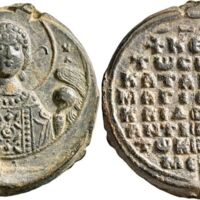Katakalon Kekaumenos, Duke of Antioch
Reference Description
The Armenian general Katakalon Kekaumenos
Katakalon Kekaumenos, Duke of Antioch, 1056. Seal (Lead, 34 mm, 27.50 g, 12 h). M/I-X/A Facing bust of St. Michael, nimbate and diademed, holding trefoil scepter in his right hand and globe in his left. Rev. +KЄ R,Θ, / Tω Cω Δ૪' / KATAKAΛω / MAΓICTPω / KAI ΔOVKH / ANTIOXЄI, / Tω KЄKAM/MЄN in eight lines. Hermitage M-8231. Spink 127 (George Zacos sale), 41. A wonderful piece of great historical interest, and with a most beautiful rendering of the archangel Michael. The obverse struck somewhat off center and with a very minor crack along the channel on the reverse, otherwise, extremely fine.
Although of humble Armenian descent, Katakalon Kekaumenos rose to prominence as a successful general in the 40s and 50s of the 11th century, fighting battles practically everywhere in the empire. He is first mentioned in the year 1039, when he commanded the defense of Messina during an Arab attack of Sicily. In the following years he fought off a raid of the Rus on the capital and combatted the Seljuk Turks on the eastern border. In the 1050s he was dispatched to the Danubian frontier, where he repelled an invasion of the nomadic Pechenegs in northern Bulgaria. During this campaign he was almost fatally wounded – we are being told that his body was found, barely alive, lying amongst the corpses after a battle. Having miraculously survived his injuries, Kekaumenos was appointed duke of Antioch in circa 1056, a stage of his career to which this beautiful seal dates. Shortly thereafter, the new emperor Michael VI (1056-1057) refused Kekaumenos' promotion to proedros and dismissed him from office. Michael's mistrust of his generals eventually led to the coup of Isaac Komnenos in 1057, in which the usurper was aided by Kekaumenos. Once he had won the throne, Isaac rewarded Kekaumenos for his support with the court dignity of kouropalates. However, Kekaumenos was not only a successful general, but also a sophisticated writer: he apparently wrote an autobiography, which was likely used by the historian John Skylitzes as his primary source for the events in 1042-1057, and he corresponded with the philosopher and historian Michael Psellos.
Katakalon Kekaumenos, Duke of Antioch, 1056. Seal (Lead, 34 mm, 27.50 g, 12 h). M/I-X/A Facing bust of St. Michael, nimbate and diademed, holding trefoil scepter in his right hand and globe in his left. Rev. +KЄ R,Θ, / Tω Cω Δ૪' / KATAKAΛω / MAΓICTPω / KAI ΔOVKH / ANTIOXЄI, / Tω KЄKAM/MЄN in eight lines. Hermitage M-8231. Spink 127 (George Zacos sale), 41. A wonderful piece of great historical interest, and with a most beautiful rendering of the archangel Michael. The obverse struck somewhat off center and with a very minor crack along the channel on the reverse, otherwise, extremely fine.
Although of humble Armenian descent, Katakalon Kekaumenos rose to prominence as a successful general in the 40s and 50s of the 11th century, fighting battles practically everywhere in the empire. He is first mentioned in the year 1039, when he commanded the defense of Messina during an Arab attack of Sicily. In the following years he fought off a raid of the Rus on the capital and combatted the Seljuk Turks on the eastern border. In the 1050s he was dispatched to the Danubian frontier, where he repelled an invasion of the nomadic Pechenegs in northern Bulgaria. During this campaign he was almost fatally wounded – we are being told that his body was found, barely alive, lying amongst the corpses after a battle. Having miraculously survived his injuries, Kekaumenos was appointed duke of Antioch in circa 1056, a stage of his career to which this beautiful seal dates. Shortly thereafter, the new emperor Michael VI (1056-1057) refused Kekaumenos' promotion to proedros and dismissed him from office. Michael's mistrust of his generals eventually led to the coup of Isaac Komnenos in 1057, in which the usurper was aided by Kekaumenos. Once he had won the throne, Isaac rewarded Kekaumenos for his support with the court dignity of kouropalates. However, Kekaumenos was not only a successful general, but also a sophisticated writer: he apparently wrote an autobiography, which was likely used by the historian John Skylitzes as his primary source for the events in 1042-1057, and he corresponded with the philosopher and historian Michael Psellos.
Provenance
Leu 5 Lot 582
26.10.2019
26.10.2019
See All Items in Category
Citation
“Katakalon Kekaumenos, Duke of Antioch,” Armenian Numismatic Research Organization, accessed April 26, 2025, https://armnumres.org/items/show/1240.


